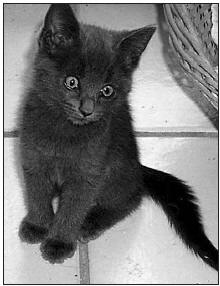Group finds homes for campus felines
By Judith Smith
A
little movement in the shrubbery catches a person’s eye. The person turns to look, expecting a bird, perhaps. But instead it’s a kitten. Abeautiful gray kitten, no more than eight weeks old, with blue eyes, gazing back at the person. What’s a kitten doing on the ASU campus? Trying to survive, just like the other feral cats who make their homes under various buildings and shrubs all across the campus. "There are probably at least 60 feral, or wild, cats on the Tempe campus," said Ig Tsong, a physics and astronomy professor. Tsong, one of the "cat people" who help care for the homeless felines, said people – including students moving away – turn unwanted cats loose on campus, thinking someone will adopt them. But once the cats become feral, it’s difficult to capture and tame them. Feral cats have lived on the ASU campus for a long time, and until recently, there was no united effort to help them. Priscilla Benbrook, an administrative secretary in the Chemistry & Biochemistry Department, got the ball rolling, spending a lot of her personal time searching out the "cat people" on campus and bringing them together. "I had been trapping cats on and off since 1992, when I was an undergraduate. I knew there were a number of concerned individuals investing a lot of love and effort in maintaining the cats on campus – a lot of cat people lurking in the bushes," she said. "In the fall of 2001 I came across a kitten in a trap and finally had had enough. In January of 2002, I started this group." The new nonprofit organization, Mild Cats at ASU, set up a Web site, and immediately implemented a "TNR" (trap, neuter and return) program on campus, in line with the latest TNR policy implemented by the Maricopa County Animal Care and Control (which pays for neutering and rabies shots). Mildcats, as the group informally calls itself, tries to place the cats or kittens if they can be socialized. Otherwise, they are brought back to their "homes" on campus, after they are neutered, and volunteers continue feeding them. Trapping the kittens and cats is almost the easiest part. The most difficult factor is finding homes for them. Most of the "cat people" already have a houseful of felines, including several ASU cats, so Mildcats is looking for cat lovers to step up to the plate – and to make lifetime commitments to the cats, Tsong said. To see pictures of kittens needing homes or to volunteer or donate food, go to (www.mildcatsatasu.org). And that gray kitten with the blue eyes? Sorry. She’s already spoken for.Smith, with Public Relations, can be reached at (480) 965-4821 or (jps@asu.edu).

This small kitten is one of many found by Mild Cats at ASU, a non-profit organization that finds new homes for stray and abandoned kittens living on Main Campus .
![]()
Animal Control sets records with more adoptions, less euthanasia
By Christina Leonard, The Arizona Republic (Monday July 15th 2002)
Ten years ago, Maricopa County Animal Care & Control had a reputation as one of the worst programs in the country. Today, it's thought of as one of the best, according to the agency's director, Ed Boks. "To the best of our knowledge, we're the Number 1 pet adoption agency in the world," Boks said Friday. "We have really turned the corner here." Boks and his staff are celebrating their latest accomplishment: For the second year in a row, the agency broke its own records in pet adoptions and preventing euthanasia. During the past fiscal year, which ended June 30, the agency handled 21,425 pet adoptions an 11 percent inrease over the year before. And euthanasia dropped 11 percent, to 28,800 from 32,542. Boks credits the turnaround to several innovative programs, including spaying and neutering services that are free to low-income families, a consumer-friendly pet adoption center in central Phoenix and the "Scratch & Sniff Petmobile", a bus that brings adoptable dogs and cats to community events. Agencies nationwide have asked about the programs, he said. The euthanasia rate is the lowest in the agency's history. It is nine per 1,000 residents today, compared with about 25 per 1,000 residents in the mid-1980s. Boks' goal is three per 1,000 residents in the next few years.
This site was last updated 09/28/02